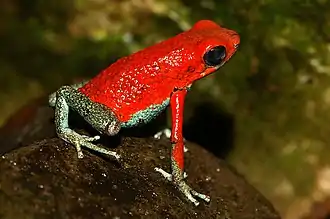Oophaga
Oophaga is a genus of poison-dart frogs containing nine species, many of which were formerly placed in the genus Dendrobates.[1] The frogs are distributed in Central and South America, from Nicaragua through the Colombian El Choco to northern Ecuador (at elevations below 1,200 m (3,900 ft)).[1][2] Their habitats vary with some species being arboreal while other being terrestrial,[3] but the common feature is that their tadpoles are obligate egg feeders.[3][1][4]
| Oophaga | |
|---|---|
 | |
| Oophaga pumilio | |
| Scientific classification | |
| Kingdom: | Animalia |
| Phylum: | Chordata |
| Class: | Amphibia |
| Order: | Anura |
| Family: | Dendrobatidae |
| Subfamily: | Dendrobatinae |
| Genus: | Oophaga Bauer, 1994 |
| Type species | |
| Dendrobates pumilio Schmidt, 1857 | |
| Diversity | |
| 9 species (see text) | |
Etymology
Oophaga, Greek for "egg eater" (oon, phagos),[5][6] is descriptive of the tadpoles' diet.[7][8]
Reproduction
While presumably all dendrobatids show parental care, this is unusually advanced in Oophaga: the tadpoles feed exclusively on trophic (unfertilized) eggs supplied as food by the mother; the father is not involved.[1][4] Through the eggs, the mother also passes defensive toxins to the tadpoles: Oophaga pumilio tadpoles experimentally fed with eggs from alkaloid-free frogs did not contain alkaloids.[9]
Species
There are nine species in this genus:[2]
| Image | Scientific name | Common name | Distribution |
|---|---|---|---|
| Oophaga arborea (Myers, Daly, and Martínez, 1984) | Polkadot poison frog | Panama | |
 | Oophaga granulifera (Taylor, 1958) | Granular poison frog | Costa Rica and Panama |
 | Oophaga histrionica (Berthold, 1845) | Harlequin poison frog | El Chocó region of western Colombia |
 | Oophaga lehmanni (Myers and Daly, 1976) | Lehmann's poison frog | western Colombia |
| Oophaga occultator (Myers and Daly, 1976) | La Brea poison frog | Cordillera Occidental in the Cauca Department of Colombia | |
 | Oophaga pumilio (Schmidt, 1857) | Strawberry poison-dart frog | eastern central Nicaragua through Costa Rica and northwestern Panama |
 | Oophaga speciosa (Schmidt, 1857) | Splendid poison frog | Cordillera de Talamanca, western Panama |
 | Oophaga sylvatica (Funkhouser, 1956) | Diablito poison frog | southwestern Colombia and northwestern Ecuador. |
.jpg.webp) | Oophaga vicentei (Jungfer, Weygoldt, and Juraske, 1996) | Vicente's poison frog | Veraguas and Coclé Provinces of central Panama |
Captivity
Oophaga are kept as pets, but they are challenging to breed in captivity. Oophaga pumilio, however, is easier to breed and popular.[3]
References
- Grant, T.; Frost, D. R.; Caldwell, J. P.; Gagliardo, R.; Haddad, C. F. B.; Kok, P. J. R.; Means, D. B.; Noonan, B. P.; Schargel, W. E. & Wheeler, W. C. (2006). "Phylogenetic systematics of dart-poison frogs and their relatives (Amphibia: Athesphatanura: Dendrobatidae)" (PDF). Bulletin of the American Museum of Natural History. American Museum of Natural History. 299: 1–262. doi:10.1206/0003-0090(2006)299[1:PSODFA]2.0.CO;2.
- Frost, Darrel R. (2014). "Oophaga Bauer, 1994". Amphibian Species of the World: an Online Reference. Version 6.0. American Museum of Natural History. Retrieved 31 August 2014.
- "Oophaga — the obligate egg feeders". dendroWorks. 2011. Archived from the original on 11 August 2016. Retrieved 12 September 2014.
- Vitt, Laurie J.; Caldwell, Janalee P. (2014). Herpetology: An Introductory Biology of Amphibians and Reptiles (4th ed.). Academic Press. p. 490.
- http://www.etymonline.com/index.php?term=-phagous
- http://www.etymonline.com/index.php?term=egg
- Heselhaus, R. 1992. Poison-arrow frogs: their natural history and care in captivity. Blandford, London.
- Zimmermann, E. and Zimmermann, H. 1994. Reproductive strategies, breeding, and conservation of tropical frogs: dart-poison frogs and Malagasy poison frogs. In: J.B. Murphy, K. Adler and J.T. Collins (eds), Captive management and conservation of amphibians and reptiles, pp. 255-266. Society for the Study of Amphibians and Reptiles, Ithaca (New York). Contributions to Herpetology, Volume 11.
- Stynoski, J. L.; Torres-Mendoza, Y.; Sasa-Marin, M.; Saporito, R. A. (2014). "Evidence of maternal provisioning of alkaloid-based chemical defenses in the strawberry poison frog Oophaga pumilio". Ecology. 95 (3): 587–593. doi:10.1890/13-0927.1. hdl:10669/76946. PMID 24804437.
| Wikispecies has information related to Oophaga. |